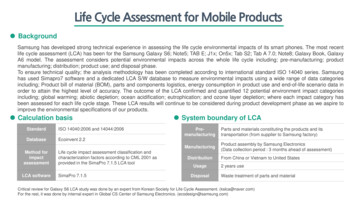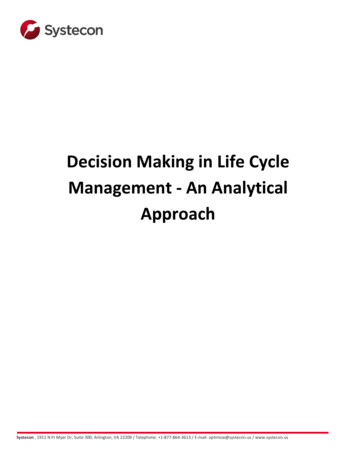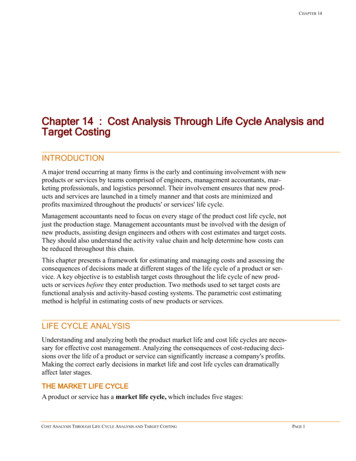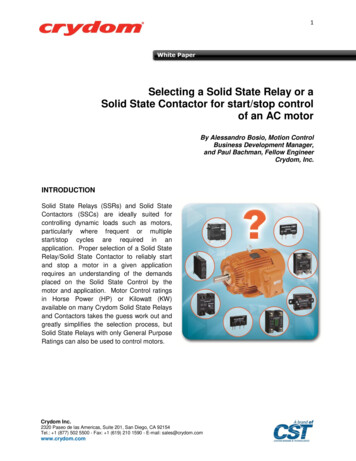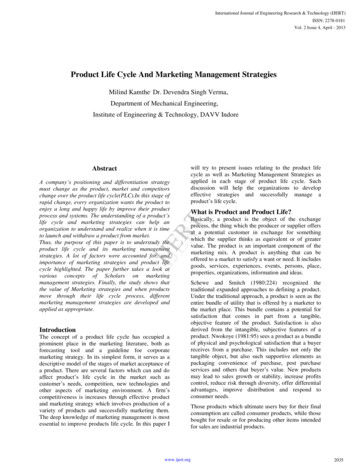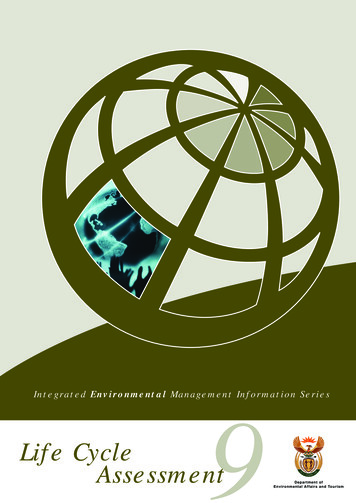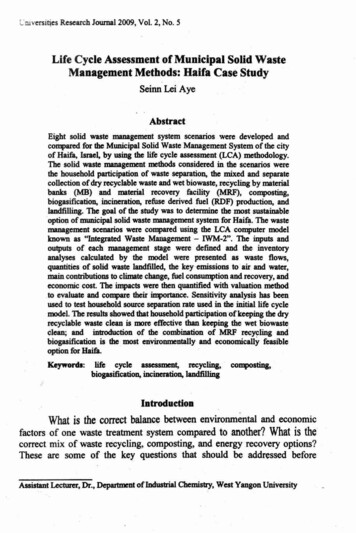
Transcription
L: DJ "enitjes Research Jownal2009, Vol. 2, No.5Life Cycle Assessment of Municipal Solid WasteManagement Methods: Haifa Case StudySeinn Lei AyeAbstractEight solid waste management system scenarios were developed andcompared for the Municipal Solid Waste Management System of the cityof Haifa, Israel, by using the life cycle assessment (LeA) methodology.The solid waste management methods considered in the scenarios werethe household participation of waste separation, the mixed and separatecollection ofdry recyclable waste and wet biowaste, recycling by materialbanks (MB) and material recovery facility (MRF), composting,biogasification, incineration, refuse derived fuel (RDF) production, andIandfiUing. The goal of the study was to determine the most sustainable'option of municipal solid waste management system for Haifa. The wastemanagement scenarios were compared using the LeA computer modelknown as "Integrated Waste Management - IWM-Z". The inputs andoutputs of each management stage were defined and the inventoryanalyses calculated by the model were presented as waste flows,quantities of solid waste IandfiUed, the key emissions to 'air and water,main contributions to climate change , fuel consumption andrecovery, andeconomic cost. The impacts were then quantified with valuation methodto evaluate and compare their ilqIortanee. Sensitivity analysis has beenused to test household source separation rate used in the initial life cyclemode l. The results showed that household participation of keeping the dryrecyclable waste clean is more effective than keeping the wet biowasteclean; and introduction of the combination of MRF recycling andbiogasification is the most erivironmentally and economically feasibleoption for Haifa.Keywords:life cycle assessment, recycling,biogasification, incineration, londfillingcomposting,IntroductionWhat is the correct balance between environmental and economicfactors of one waste treatment system compared to another? What is thecorrect mix of waste recycling, composting, and energy recovery options?These are some of the key questions that should be addressed beforeAssistant Lecturer, Dr ., Department ofIndustria1 Chemistry, West Yangon University
of any waste rnanagcmcnI opcralion (Nibson-Djcr( andM Doupll. 2(00). The appIicatioo of life cycle ISXSSUXOI (leA) in 1Ix. ft\IIII&ClllCOI sector bas nc a useful 1001 in compuinJ 1Ixen\itonmcntal and cconomic cost of altemalive . aunmt s)'1tcmsand idcntifyinll 1Ix most fmnblc one for s)'S\Cm pctformanccimprovement.C()CtlInalCCma lIsrael Ministry of EmiroolDeutal Proccction has a wieleof laws and rcsuJatioos 00 solid waste. However, municipal solidmanascmcnt is still a COlIlinuous ehall in Israel. Since 2003. 1IxCentral Bureauof Statistics (CBS)of IsrllCl began condUCIinll S\In'C)' on thequantities of domestic. comm ial and yard waste collected by localaulhoritics. The information c:oIIected by 1Ix CBS and 1Ix MiniSll)' of theEnvilOlUlXllt has improYCd the available waste data (CBS. 2006). Haifa isthe lafKCSt city io Northern brael and the thinl.lafKCSt cil)' in the coually.with a pop"'a1iQn of about 267.700. Accordinll to the latest SU1\'CYcoaduetcd in 200S.the amount of'cotal waste llCflC1&lCd in Haifa is 160.736tolVyr aod waste gcacntioo rate is 1.6S ks!capilllday (or) 601 ks!capita/)T.The OtpIlic matcriaIs an: 1Ix maio compoocats of theSU'Cam. intermsof wcig/lt. constituting 3 of Haifa'ssolid waste, followcd by paper2ao J-pcr 22%, canIboard 6%) and pl&1lic 13". (film I2%, risid I%). Therest arc sUss S%, textile 3". diapers 3%, mctaI 2% (Fe W. Fe 1%).and miscellancous 8% (Israel Min ofEnvironmcotal Proccctioa. 20(6).ran . LCA has a Ill( 10 ofTer in terms of sclcetioa and application ofsuitable MSW manascmcnl IcchniqllCS, tcchnolOllics. and propms 10achic\'C specifIC waste rnanagcmcat objcc1i\'CS aod Thus, SC\'CraIstudies in the literature used the leA as a 1001 for municipal solid . manascmcnt (Soncsson et II. 2000; Arena et II 2003; DaIlJbo et aI. 2005;A)'C aod Wtdjaya. 2006: Bovca aod Powell. 2006: Oz.eler et aI. 2006:Emery et II 2007: lee et aI. 20(7)The objective ohhis study was 10 usc the LeA as a tool 10 comparedifTcmll solid waste DWl&&CIfICnI S)'1tcm opcions and detmninc the mostfeasible s)' lCm for Haif. Israel. To this purpose, asht difTerent scenariosof municipal solid waste manascmcnt (MSWM) S)'1tcmS that includedifTerent municipal solid waste proccssins and disposal methods wen:clcvclopcd aDd, tbcn, compercd with respect to their environmcatal impeclJand costs by usinll the Iatqratcd WISlC Mana&cment - IWM·2 MocIclclcvclopcd by McDoupll et aI. (2001).
)IMftlaodolol)'Scope n.ltlo.Eielll dilTCfalI ICcnarios of mllllicipal solid waslc nwuscmmlS)'Ilcm lhil include dilTetaIl solid c procCfoSinB and disposal mechodswere developed and compamI wi!h respect 10 lhrir mvironmcnlal impxuand economk cost. The solidmanagcmcnl mclhods considered in !heI«Nrios were !he howchold participalioo of waslc scpanlion. !he mixedcollection Of lhc IC'J*&IC collection of city rccycbb\c wasIC Of wet biowask.recyclilll by IIWCrial banks (MB) Of material rccovuy faalily (MRF).compostin80 biopsiflWion, incincntion. rct\ase derived fuel (RDF)production, and landtilling. Environmcnlal impxts were cvalualed byconsidering lhrir e now. quantities of solid waslc landtilled. keycmWions 10 air and walcr. COftlribubons 10 climate chan C. fuelCONUIllpcion andrceo,cr)'. andeconomics. The rcsuIlS lakeinlO account !heu and clowns1ram cmiuloas and rcsoun:e COftSUIIlpcion auocialedwi!h CtlCfIY rceo'CI')'. avoided usC of COftvmtionaJ fcrtilizcn. and !hea"Oid nce ofvirJin maIaialsduc 10 rccyclinJ.n .ctloeal V.le ad S1JCftD Boead.riaThe function oflho.)'Item IIIIdcr atudy is 10 tMrI& C household solidwaslea in !hearca of ltUdy. The IIInction.1 unil selecled for the comparisonof lho a1lcmalive accnarios i.lho managcmcnl of I lOMe of municipallOlidwute. The S)'Ilcm bouDdaricsaclcelOd fOf lhc lifecycleof solidwute weredetined as lhc momcnI when materiaI 1O have value. becoming eand ,.ilcn e bce lmcs incIt landtill material Of is COftvaled 10 air an4'orwiler cmWions Of rcpins some value.Wule M". C esenartosThere arc cisht waslc management accnarios anaJyzed in lho scudy.Full dcKripcion of lhc accnarios is giVUl in Figure I.
2009.Vol.2.-Me"tIarklaf.M'I)'CWIfClIlCOlIlfOIl1- -aDfr-naDfs
Uaivm ibe'S RCI.urchJOW"'DlI 2009. VoL2. No. SLIft Cye le In"tnIOI')'The data collection was mainly based on 'he projects conducted b)'lsrael Mini'lry o f Environmenu l Protection and ShJldag En\i ronmenlJlSolutions lUld Management I.td, (1.1 Minislf)' of EnvironmentalProtection, 2006/, CBS or Israel (CBS. 2(06) and the resources availableonline :at the website or Israel Minis1ry of Environmental Protection,hl1r:// \\\\ \ \ .:\\ i \ ;;t .\: t\ \ .il, Tbese data include population . aste generationrate, waste chJrac,eristie, and compositien. .:ute management appliealion,USC of lransfer stalions and landfill sites, tbe cost ,,'eulations for lhealtemstives and operational recommendations for ,he landfill site.The Ufe Cycle Inventory (LCI) constitutes a detailed compilaticn of.11 environmental inputs (ma,erial and energy) and outputs (air. waler andsolid emissions) during e.ch Slage ofthe life cycle of tbe waste. An LCI hasbeen completed for . 11 the aetivities required 10 manage the waste from thelime il leaves the household 10 its ultimate disposition: the householdparticipation of waste separation. the mixcd collection or ,he separaleeolleetion of r«: )'C lableldry waste or bio/wet wUl e. the management of thewaste in a malerial bW. transfer sulion and/or in material recoveryfacilily. the recycling process of recovered fraclions. Ihe composting orbioga., ific'lion process of the biowaste frac,ion.lhe incineralion process orresource derived fuel production process. and the managernen, of \he wUlein \he landfill. The savings from energy generation from electricity,compost (avoiding fcrtili,.en) and recycled material (avoiding virginmaterial) have also been includcd in the model.Val.aUoDThe environmental imp eu resulted from the model were quantifiedand converted into monetary units by valuation method, The externalitiesfor global warming pocential and air emissions wen: eslimatcd from lhefindings of \he work ofEshel ee al. 200S.SrDlIUvltyADalyslsSensilivily anaIysi. has been used to test \he assumption used in \heinitial lire cycle model by varying household parlicipationlsoorce sepantionme, The effeet of ehanging \he percentage of SOU1CC separation tate ofwaste from gO";. to 60% has been studied.
Res Its lad Disc: u-Recycled M terials: collected recycl les marketable products fromRDF. cominb"opsific ion. This caD be also named O\-erallII erial R«o\include: RDF fuel lost due dlyin and pell i "ng:"rlC&tion process lost due 10 moi ture 10 and---landfill:te sent (or Imdlillina without ptC'"trabncnt residues after:lJ\Y trearment processesT le 2 presents the amounts of wasu: bcin sent (or disposal tobndfill lakin intot a MJj(e cycle pcnpcctivc" - i.e, considering alsoupstream and do nstream l'CCfuctions. or inaeasc.s. in wastes going 0landfill associ ted with the production of compost.the generationof energy.and the voidance of cxtrxting virgin materials due to recycling.
v."u . ie, a-dl J uooI2009. Vol 2, No. 4) Table 2 Net a",onnll originating rr- waste mmagancnt opcntioc a a. dfinal solid waslC destined fOf 1aDd1i1l(ID Sc mrio 0.190· 27,731102.460J6 .J%75·27.73127.502n. (,()· 27,731.2,070101.3%II')90650906SS" .0%·5 ,I Rrq 39.6301.967" .4%7J6,2OS4,232l.n396-4.49937,71976.6% J6,2OS3.717l ,n396-4.49937,2GC76. 452 . 1·· Rate Landfill DiversIonOlmate CIIaJ1&eThe "G Wanning Polential" (GWP) is expressed in CO:equivalents md calculated fOf CO:. Clio md N:O using the followingrd.uioawp: I :0 -21 CH. -310N:O.Table 3 EfTed ()Q the climate clw1gc, rcOeded I I Global Warming POIcnlial(in tOMCS ofco, equivalenll: «ftI.rio.,.:" 101Oo.Pul1.223632J64236 (,5169····615·6169615" ,35273741.012770·1,110·1,504O. (.,,1.'P 2.764109,631611··24,975. 14,65 112.6117924.975·14,0077.46944·37, 16524.9)1.7.79 1. 17,127. 111··170.42710 9129,2n10&
vatU Cia . . . . 2009. Vol 2. No 5A!rE."The raul here like iDIo ICCOUD! both the direct air ani ions with Ibo. . . m . . . . . . . . pncbccI. Ibosc aYOidcdd 10 coqIOSfi. ficIIioa.CDa8)' SCDCIIIioa.IDd TIbIc . prceaa Iir eminjons. ICCOIdiDa 10 &be lCClllli0n5. II iswonIa DOCiD&dUysia was carried oatin &enDs or ocheremil. e.a. for dioxiDllfar-.,. IDd 1DCmIr)'. buIthe raulted impecta were rcIIriYdy ncPaibIc or zero. beDce DOt pi clCdeclTable. Air emiaioDI.ccordin &0 1be s.6S6,,-.76,Z01 I.'. 01' .-)B. ;' n r .26'-45,3)0C76.7.517-SS.tQJ"'.6)1·2 6.719ZOIJII0&.6907 .6I1.-214.317·2.t99·S).1.641.S9.26t ·54,4IS.11·DUJO··1.276W. E.Table S prelCftlithe water emissioaa &om a lifo C)'Cle penpcct,veCltimaaed usina Ihe (WM·2 model. II is worth DOCina Ihal for emiJlions 10WIICI' Ibe 1DIl)'lil was carried out DOt oaty in ICIIDI or BODICOD. TOe.lUll' coded IOIids. ebIoride. DicnIe. IU""", baa abo e.a. for diox pbcooIs. DIDOIlium. II'ICDic. barium. cadmium. dRmium. copper.C)'Iftide. fluoride. iroa.lead.lDCl'CUlylDd . . . . .e However. abe relUltlnlcmiMioal were citbcr rdIIiYcIy aeati&ible 00IIIpIIQl1O IboIc reponed orwere zero. beacc DOt prOClllCd
437UlUvmitia Racucb JounaJ 2009.Vol 2. No.5Table S Wateremissions ac:cording 10 the scawiOlSccaa·riofmjMioNrocCODDOD(blopunI)ssaso. NO;.10.156·SI-21.77069.23971.120 199.71011.011-1.120.02369.Wn.013377 1.411-1.112.6tOJl7.m4·310FlattTable6 prcsenls the toIaI fUel fioma lifec)'tle peaspc:clive estimatedusinglhc IWM-2 model. The results of this analysis take into account bothIhc amount of fuel used associated with the WIlle IftIRIICInCnl pnctices. as\\'ellas those avoided due CO gencnIins cneIJ)'. and n:c)'tling.Table6 Tocal fuel. considerins a life cycle Iical. .IfiURecrcl-Toca1F\lcl(lo'oJJyr)--I-24344.4.S3IS3 4306799-171.15·ns-1.217-73.71.
Univasities R s ud JoumaI2009, VoL2, No. 54) 8E onomlcCostTable 7 presents the direct economic cost for waste managementscenarios from a life cycle perspective estimated using the JWM·2 model.The values used for the revenue of dry reeyclables were (paper S28.5/Ionne. glass- S7.5ItOMC. ferrous metal S294.5Itonnc, plaslie S4301tonne).Table 7 Economic cost of waste management alternatives in Haifal-5«.Coliee-Son·Biok -1b r.Land·Rcqo :.nariobO lllll:aiealmalfill1 8I.2. 1, 67). 1) 674· 1) 6754,369" ,1)62,91964,369".1362,05075, 10781191S85, 107a ll840······3,726··Total COSlCosu)'tal)(SilooDC)( I O '·10,045628,m2246,8l4)930582· 5225,2 193)2.7632. 194·5222,86819··3,149·2.9362,665173, 6,82742··10,045Enviroamenlal CoslTable 8 shows the environmental cost for !he pollutants of globalwannine potential and air emissions caused by wastc managanentoperations of esch scenario. The unit values used were (CQz - SO.0238/kg. - SO.6242/kg. N20 - S6.334/kg. Particulate Malter.: S36,1S6Ikg, NO.- S6.81041kg. SO. - S5.383/kg. Hcavy metals S293/kg), following EsheleI aI., 2005.
s-.co,Mat.,."'.0I"1Z6)1JI"lMl 0.1)70·Ut"'·12'"·12,4674JII1I-at"I oYJ9J'O"I."" .so.NO.11M4I-·lIt.,.,. " IO·1.m.1710e.-(I .zuZJ61.Im·12.ZJ ·1.·16.n.,-tJO.I.IS)·n.".IJQ·17 .zst4'0.1.,.'ztI0111.1.7M.)).54t2M04)1.T.C'. .00. fCde- " I"Cc.oirl mrl . eCDaD.cClOIlIor .1ft l1li opcrIIIioM ofClIda ICICMrio.TIWt'.TlWt9 Nee ClOIl01'.IIIenIIIiv. iDHlitaI.,ZU)t.",.10M)Js.tlt614s.a»4U6I.ZJ2,IUII .,.-»2.6ZI161.7»1.103,'-'OZoJ.D).OIZItUl7 2"SM16I!ClGMIIIIcs-io, 7CIOII( )fa t'CIOII( NlcClOll( 1.125NIcColIcs.--).9Z)7
Unl.nilln Rne&rch Joun aI 2009,Vol 2. No. sentral Dbc1InloaThe IWM·2 model indialed 1Iw s«nario 114 seems to be lbc bestalttmalives when considering lbc t ofwaste going to lhc landfill andfuel But this s«nario has a ntgative cnvirol'llDallal impacts 0Cl globalwarming pocentiaJ. Again, socnario ItS also seems to be lhc best alternativewhen considering envirol'llDallal impacts on gIobaJ warming potential. air.missions and wattt e.l1inl ms for IOlid wute lrealmenL NcvCltbcJcss. lhcopcnting cou fOt this r.eru.-:o is very high. Scawio 116 is !be best cboicc:1Iw cou I , in all lhc scawios, and it still involvcs CD,iloilmtolllimprovements. Therefore, if lbc budget is light and lbc cnvirol'llDallalsilUalion dcm.ulds improvcmc lis, sccrwio 116 could be a right choice. Themodel also showed 1Iw biopsiflC&lioo is more attractive l/un c:ompostingin lhc casc of biologjal bca'Ii llt'methods. Bert to oIhcr wasteltealmCDl mcIhods. compolting s«nario 'S is still an inlcrcsti:lg option.1Uch cou lhc second IusI aIlct s«nario lJ6 and it also has low ntpliveCIlviroamcnUl impacu.In order to clearly dcflftC lhc most n'OClnble a1lemalivc, lbcenvironmcnUl impactS resulted /'rom lhc modcI were converted intomonetary IIIlits by using lbc values cstimalOd from the previous h .By involving these values, we can eontlude 1Iw scenario 116 is lbc mostcnvironmcnUlly and economically feasible option for Haifa. Scawio 'Sand lIS arc second fa\'OW'ab1c options and socnario 114 is lbc third one. Wecan also concluded 1Iw household partici oo of keeping lbc dryr C)'elable waste clC211 (Sccrwio /IS and 1/6) is more efTcdive lh.1n keepinglbc wei biowaste elC2ll (Scawio 111 and lIS).F.xpmding lbc studied s by changing lhc source scpnIion ratemade lbc R lllts more comprcbcnsive compared to lhc original case: study.The sensitivity analysis indicaled 1Iw IOIIrCC scpnIion rate would play animportant faCIOt if oocof lhc intensive m:ycling scmarios ('S Ot /16), wbcrclhc dry waste is kcpC clem, is to lhc city. Bul., source scpnIionrate would not sipliflCmlly afTOCI lhc system if ooc of lhc intensivebiologjcal lrealmcnts (111 or lIS). where lbc wet is Iccpt clean. is inlroduccdto HaifL
U,,; nitin Rn ltCb Ioumal 2009.Vol.2. No. 014 1Coae/asloaManagement options vary in tams of preference when considering aloc.al perspective of e.g, landfi ll reductions versus the potential for moreglotal environmental benefits achieved through recycling, compostproduction. and energy rcoovciy. Life cycle assessment hclps quantify thesepOlential benefits and trade-offs. In this study. eight alternative scenarios tothe existing waste management system have been studied in order 10 findout the most environmentally and economically fa\'Orable Wastcmanagement system for Haifa.The lwcline scenario #1 stands for modern landfill. with gas andlexhale collection and energy recovered liom landfill gas. Scenario isintroduction of material banks fot PET bottles and 1'CC)'Clable papen.Scenarios #3 and lU pr :scnt maleriaJ bank 1'CC)'C ling follo wed bycomposting and incinenli on. Scenarios liS and 116 arc introduction of MRFfor dry l'CCyclables and followed by composting and biogasifiulion.Scenario 1/7 and 1/ g stand fot eomposting and biogasification which arcfollowed by RDF prodlietion.The lmIlts showed that household participation of keeping the dryl'CCyclable waste clean is more effective than keeping the wet biowasteclean; and introduction of the combination of MRF recycling andbiogasification is the most environmentally and economically feasibleoption for Haifa. Even though the case study is Haifa, the results can becopied 10 other cities characlerized with same waste generation rate andwaslecomposition.AckD ow &Cmeallbo . - bU 10 . . . . . llwlb 10 Dr A"", A""I M . Rc 1oI,W. Y Uaiwnily. Dr ICbiD H rror .s Ibd, I.oduslriaI Dcpaz-.:l .s mrmbm or '-mI C. c, w. Y IJ1li nily Co l!l ira!IoWla 10 - . WI anicJ .,. abo Il olet o d 10 Dr Mocdc baI.s Dr Of",A D ponmr1II or 'allnI R - . .s Ezu.hI Iwt.t:aiwniIy, . Co lllrir klDll . 0. "or l!l rCI ItCb faciIi ico .s lllrir ",' """ablee op nlioa. llw b arc abo & e 10 mlESCO .s Isnd e.-ciI or H Edoc&tioD for, crUIiDI me til t-lu a I 10 any 0Ul Ws rnw h.
U"h.ili . R uch k lmol 2009. Vol 2. No. SReferencesPelV inJ. F. (2003). The: mvitonm:nul pnfomwlCe ofalternati ve solid wute mlAa&C'mcc1 options: a life cycle useumen1. tudy. Cbcmic:11 En&i-rill JOIIfNI;96:207-22 .Aye. l. & Widja)' . E. R. (2006). I and «OIlOmic: anal)' . of . 1 dispo.1options for lr ditional marlcnr in lodonc:.1&, WUI MUlIg m lll.26:II SO-91.Ilo, . M. O. & P ll J. C. (2006) . AIt mabW nwioa 10 lDCCI Ib cI mlDda of.inahk"UI .g m lll.Joumalof EnvitO lm ilUI laDa g m 1ll; 79: I I S-32.ens C.a1 o.u elU of SutU ica (2006). En. i. 0 . C (No 2),J Nllkm, b,ac lo.hJbo, II. Ko,bl&, So. Uukb. J. MyII T. Jouttij1ni, T. MeW ra, M. &.Tn Ilw m, J. (2OOS). Life C) k inwlllO y UlaIya S fo: fiw "UI rnao.agrm 1ll op iom for Itd d 1lC""P"pn. WUI laDa ge uc h;23:291- 303.Emery. A. DI";. A. Griffilha, A. & wmiams, I:. (2007). E"vironme"tal and rrono micmrwkllina: A e ,tudy of nuUcipollOlid . rnao.a& m nl lCenuiOiIn WII es, RetOUr«l. COllK1Vlbon and Rrr )'Cling;49:244-63.Eshr T A)1'lon, O. & Sl rd kr. M. (2OOS). A eririel l review of rronomlc vII""rio"stud;. of ext maUb. from lncinmdon and Iandf'lIing, WUI MUlI& m lIl and R h;2 3 :487, S04 .IES.J.tiNI (or Environmml and Slntainahilily (2007). Enviro lmrDtal A.me. ' ofMunicipal W. Managcrn nt S«nuios: PII1 I - Data eoll«tion andp«limizwy . - for tife C) 1e lhInkina pdoc Illldiea, JCR Srinllir. and TcdIIlicaI RtportI2.19.bnel M. auyof [.n ,i1oawc llUl Proe clloa (2006). RcaldcaliaI aolld lioo ,Nltional2005-2006, Shal4aI' En.ir e m:1lUI Soh';"". andMana ", lid.L«. Soli. O ol. 1:.1. Oaako. M. & Doac. JJ. (2007). Evalualloa of mvitoom r taI bunlcmcall1Cd by e!wls 1 of f . mu lgcmcol i}\lCtm in S ouI, K.Srico« oflb Toeal EnvV0runn0;337:42-S3.M.Doupll F. Whi. P. Fnnke. M. & lIiDd1c. P. (2001 ). Inlegnf d Solid Wu.Management I Uf. Cycle IJIV 1l1O y. ed, 8laekell Seieeee lld.N,ls"'DoDjcrf. J. & MeDoupll F. (2000). Socialfaclors In .uslliNble wule rnao.agrlll lll.Wanner 8ull ;73:11I-20.Ozeler. D. yetis, U. & Demircr. O. N. (2006). Uf. e)'C1eof .ipoioolid.1Ie . "1 mcIhods: Ank&n cue INdy. Environmcllll"temabonat:32 S - I I.Soocuon, U. 8jo'rkJuDd, A. . Car1slOo, M. & DIJemo. M. (2000). EavirooRlclIlII andccooomic UlaIysis of ,mac 1}\lCtm for biock&fldable "UI .Resourc s, CometvItiocl & R C) Jma;2I:29-S3.Winkler. J. & DiUlCwsId, 8 . (2007) . eYllualioo of Uf. e)'Ckmodels for lOUd MIl W. Manaa 27:1021- 31Arena. U. Maslellor . M.L, &sun.,.W IIm Il'
compared for the Municipal Solid Waste Management Systemofthe city ofHaifa, Israel, by using the life cycle assessment (LeA) methodology. The solid waste management methods considered in the scenarios were the household participation ofwaste separation, the mixed and separate collection ofdry recyclable waste and wet biowaste, recycling by material


